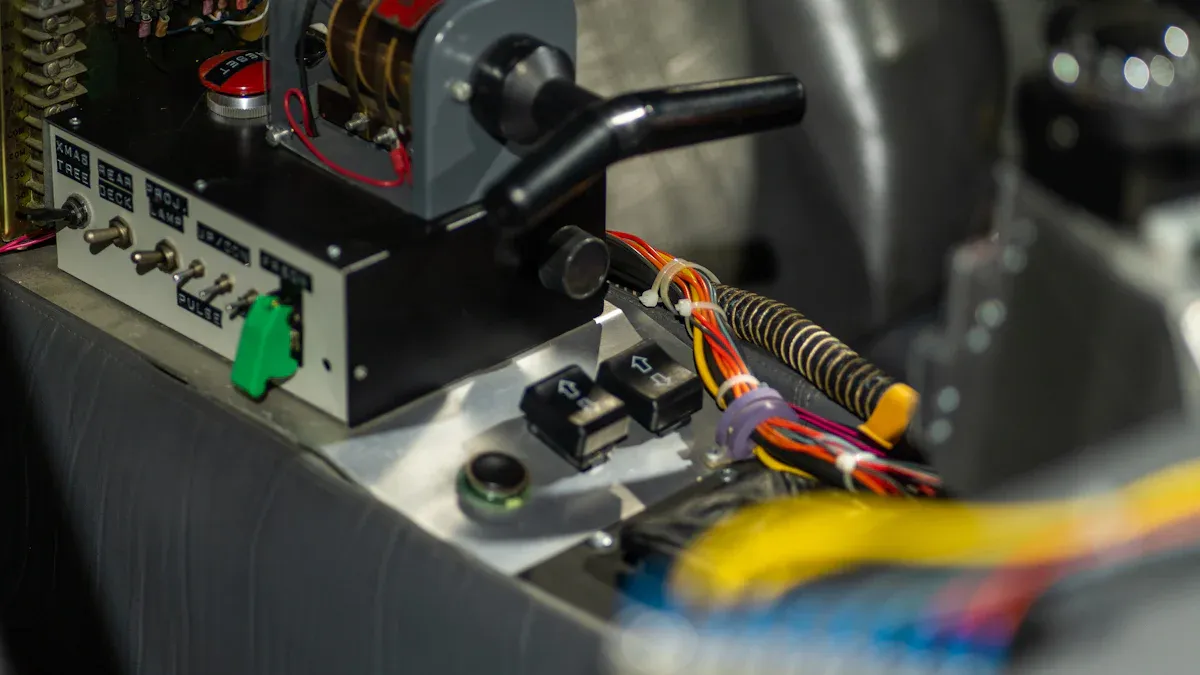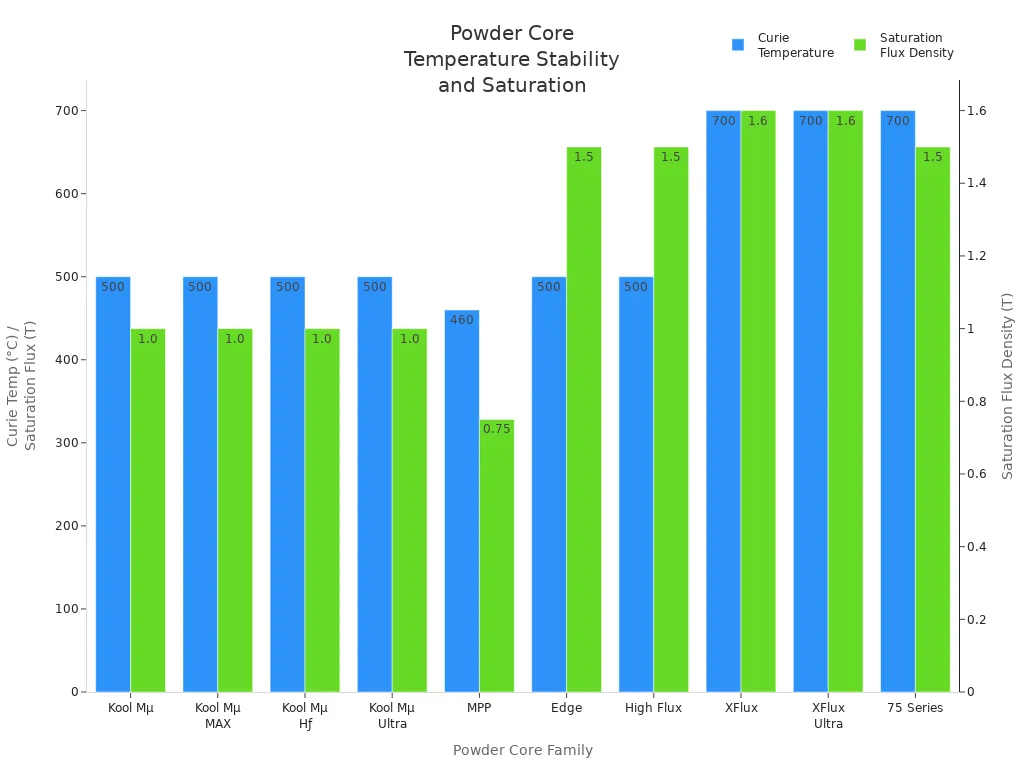
Choosing the right Inductor Core Material affects how your power electronics work. You should look at a few important things:
-
Frequency range
-
Current rating
-
Core losses
-
Cost
-
Air gap design
These things decide how much energy your inductor can take. They also affect how well it works and how long it lasts. Many companies use ferrite and alloy cores to make things work better. These materials help devices work well in tough places. If you pick the right material and shape, your device will work better and stay steady.
Key Takeaways
-
Pick your inductor core material by looking at your circuit’s frequency, current, and temperature needs. This helps you get the best performance and efficiency.
-
Powder cores
have soft saturation and steady performance. They also handle heat well. Ferrite cores give high inductance and block EMI at high frequencies.
-
Think about core losses , saturation, and wire design together. This helps lower heat and energy waste in your inductor.
-
Balance size, cost, and thermal management. Small inductors save space but can get hotter. Bigger ones handle heat better but cost more.
-
Use design tools and datasheets to find the right core material for your project. Always test your design to make sure it works well and lasts a long time.
Why Core Material Matters
Performance and Efficiency
You want your power inductor to work well and not get too hot. The core material you pick is very important for this. Each material has its own magnetic features. These features change how much energy the inductor can hold and how much heat it makes. Some materials can take high currents and do not get hot fast. Others keep losses low when the frequency is high.
Tests show that the right core material helps control heat and energy loss. If you use a material with high saturation magnetization and good permeability, your inductor can take more current and work at higher frequencies. You should also think about how the wire is wound. Solid flat wire can lower resistance and help cooling better than other wires. When you match the core material and wire design, you get better efficiency and less wasted energy.
Tip: If you model resistance and core losses well, you can choose the best Inductor Core Material for your project.
Core material changes:
-
How much current the inductor can take
-
How much energy it can store
-
How much heat it makes
-
How well it works at different frequencies
Reliability Factors
You want your inductor to last a long time, even in hard places. The core material and how you build the inductor both matter for how long it lasts. If you use advanced magnetic materials , your inductor can handle more power and stay cooler. This helps it last longer and work better over time.
Mechanical stress during making can hurt the core. Impurities or cracks in the material can make the inductor weak. Good assembly and careful handling stop these problems. Temperature and humidity also change how long it lasts. High heat makes it age faster, and moisture can cause chemical changes that hurt how it works. Encapsulation and special molding compounds keep the core safe from these dangers.
Note: Keeping your inductor in a safe place helps it stay strong and work well for many years.
Inductor Core Material Types

There are many powder core families you can pick from. Some examples are MPP, High Flux , Kool Mμ, Kool Mμ MAX, Kool Mμ Ultra, and XFlux. Each family uses a special metal mix. They all have a spread-out air gap inside. This air gap is not in one spot. It is spread through the whole core. This helps stop sudden drops in inductance. It also lets the core handle more current without failing fast. Soft saturation means the inductor can take extra current without big problems.
Powder cores work well when it gets hot. Their permeability and inductance do not change much with heat. This makes them good for circuits that get hot or cold. They can handle faults better and are less likely to break if too much current flows. These cores also help lower electromagnetic interference. The spread-out gap keeps fringing flux low.
Here is a chart that shows how powder core families handle heat and soft saturation:

|
Powder Core Family
|
Alloy Composition
|
Saturation Flux Density (T)
|
Curie Temp (°C)
|
Soft Saturation
|
Temp Stability
|
|
Kool Mμ
|
Fe Si Al
|
~1.0
|
500
|
Yes
|
Excellent
|
|
MPP
|
Fe Ni Mo
|
~0.75
|
460
|
Yes
|
Excellent
|
|
High Flux
|
Fe Ni
|
~1.5
|
500
|
Yes
|
Excellent
|
|
XFlux
|
Fe Si
|
~1.6
|
700
|
Yes
|
Excellent
|
You will see powder cores in places with high current and high frequency. They are also used where temperature changes a lot. The price depends on the material. But they often give good value for what you pay.
Ferrite Cores
Ferrite cores are the most common Inductor Core Material today. They are used a lot because they have low hysteresis loss and high resistance. Ferrite cores are made from a ceramic with high permeability. This means you can get high inductance with less wire. They work best at low and medium frequencies, up to a few megahertz.
Ferrite cores have an air gap in one place. This keeps permeability steady until the core is full. When the core is full, inductance drops fast. You need to be careful with high current or high flux. Ferrite cores can change with heat or cold. But they stay stable in most places.
Ferrite cores are great at blocking EMI, especially at high frequencies. They can soak up unwanted signals. This makes them good for power supplies, cars, and telecom gear. But the single gap can cause fringing flux. This may make losses go up and create hot spots if not handled.
|
Core Material Type
|
Key Usage Characteristics
|
Market Share / Growth Insights
|
|
Ferrite Core
|
Low coercivity, low hysteresis loss, handles high current, good high-temp performance; used in automotive electronics, power distribution, telecom infrastructure
|
Dominant market segment; expected CAGR > 6.42% through 2037; largest market size; forecasted to dominate 2022-2027
|
Tip: When you pick an Inductor Core Material, think about your needs. Powder cores give soft saturation and steady performance. Ferrite cores give high inductance and strong EMI blocking.
Selection Guide
Define Requirements
Before you pick an Inductor Core Material , you must know what your project needs. First, look at your circuit and how the inductor will be used. Here is a simple checklist to help you figure out your needs: 1. Look at your project and what kind of circuit you have. 2. Decide the inductance value and how much it can change. 3. Check the AC frequency and voltage you will use. 4. Find out the DC current the inductor must handle. 5. Write down the DC resistance (DCR) you need. 6. Check the highest voltage and how strong the insulation must be. 7. Pick the right size and shape for your board. 8. Choose the best terminals for putting it together. 9. Think about things like temperature, humidity, and height above sea level. 10. Make sure your design follows any rules or standards for your project.
Tip: Use design tools and datasheets to help match your needs with the best inductor core.
Frequency and Current
Frequency and current change how your inductor works. High-frequency circuits need materials that keep losses low. Ferrite cores are good at high frequencies because they do not lose much energy. Powder cores can take more current and keep inductance steady when DC bias is high.
You should check both the highest and average current. High DC current can make the core saturate, which drops inductance fast. Pick a core material that can handle your current without saturating. For example, High Flux and Kool Mμ cores work well with high DC bias. Ferrite cores are best for low losses at high frequencies, but you must watch for quick saturation.
The skin effect matters at high frequencies too. Materials like MnZn and NiZn ferrite have bigger skin depths, which helps lower eddy current losses. The table below shows how different materials act at different frequencies:
|
Material
|
Permeability (μr)
|
Conductivity (S/m)
|
Skin Depth at 60 Hz
|
Skin Depth at 100 kHz
|
Skin Depth at 1 MHz
|
|
Copper
|
1
|
5.8 × 10^7
|
8.5 mm
|
0.21 mm
|
0.07 mm
|
|
Silicon Steel
|
5 × 10^4
|
2 × 10^6
|
0.21 mm
|
0.005 mm
|
0.002 mm
|
|
MnZn Ferrite
|
3,000
|
0.5
|
1.7 m
|
41.1 mm
|
13 mm
|
|
NiZn Ferrite
|
100
|
0.01
|
65 m
|
1.6 m
|
0.5 m
|
Note: Always check how your Inductor Core Material handles both frequency and current so you do not have problems.
Losses and Saturation
Core losses and saturation change how well your inductor works. Losses come from hysteresis and eddy currents. Hysteresis loss depends on how the magnetic parts move inside the core. Eddy current loss gets bigger with frequency and can heat up the core.
Different materials handle these losses in their own ways. Ferrite cores have low eddy current losses, so they are good at high frequencies. Powder cores, like MPP and Kool Mμ, spread the air gap through the core. This gives them soft saturation and helps them handle more DC bias without losing inductance fast.
The table below shows how special needs change your choice:
|
Application-Specific Requirement
|
Influence on Inductor Core Material Selection and Design
|
|
DC Bias (Current Handling & Saturation)
|
High DC current can cause magnetic saturation. Choose materials that resist saturation.
|
|
AC Loss (Q Factor and Resistive Losses)
|
AC losses create heat. Pick materials that keep losses low at your frequency.
|
|
Temperature Rise
|
High DCR raises temperature. Use larger wire or better materials to manage heat.
|
|
Thermal Management Strategies
|
Good cooling and PCB design help keep inductors safe.
|
|
Trade-offs
|
Balance size, current, losses, and temperature rise. The right core material helps manage these factors.
|
Callout: Always balance core losses and copper losses. A good goal is 20% core loss and 80% copper loss for best efficiency.
Size and Cost
Size and cost are important when you choose an inductor. Small inductors save space but often have higher DC resistance. This can make more heat and lower how well it works. Bigger inductors use thicker wire, which lowers resistance and losses but makes them cost more and take up more space.
Here is a chart that compares different inductor sizes:
|
Inductor Series
|
Inductance (µH)
|
DC Resistance (mΩ)
|
Current Rating (A)
|
Dimensions (mm)
|
|
FDV0620
|
0.2
|
4.5
|
16.2
|
6.7 x 7.4 x 2.0
|
|
FDV0620
|
0.47
|
8.3
|
11
|
6.7 x 7.4 x 2.0
|
|
FDV0620
|
1.0
|
18
|
7.7
|
6.7 x 7.4 x 2.0
|
|
FDV0630
|
0.47
|
4.6
|
16
|
7.0 x 7.7 x 3.0
|
|
FDV0630
|
1.0
|
10
|
9.1
|
7.0 x 7.7 x 3.0
|
-
Small inductors save space but have higher DC resistance and get hotter.
-
Big inductors use thicker wire, which lowers resistance but makes them bigger and cost more.
-
DCR goes down as wire gets thicker, but this also makes the inductor larger.
-
Good cooling is important, especially for small inductors.
-
You must balance current, heat, and resistance when picking a core.
Material prices also matter. Copper costs have gone up, so price is a bigger worry for many companies. Some companies use new materials or designs to save money. Making things smaller can cost more and make design harder. Changes in supply and new energy rules also affect which Inductor Core Material you pick.
Tip: Always think about size, cost, and how well it works. The right mix gives you a strong and efficient design.
Material Comparison
Application Fit
You have to pick the right core material for your job. Each core type works best in certain uses. Iron powder cores are good for low-frequency power supplies. High Flux and Sendust cores are used for medium power and cars. Ferrite cores are great for switching power supplies at high frequencies. Nanocrystalline and amorphous materials are for high-end power supplies with very low losses.
Here is a table that shows how core materials work in different power uses:
|
Core Material
|
Permeability (μᵣ)
|
Saturation Flux Density (T)
|
Loss Characteristics
|
Frequency Range
|
Key Application Scenarios
|
Cost
|
|
Iron Powder Core
|
4 ~ 100
|
1.5 ~ 1.8
|
Higher losses, soft saturation
|
< 100 kHz
|
Low-frequency power supplies, industrial
|
Low
|
|
High Flux
|
14 ~ 160
|
~1.5
|
Medium losses, excellent DC bias
|
10 kHz ~ 200 kHz
|
Medium power, automotive
|
Moderate
|
|
Nanocrystalline
|
15,000 ~ 150,000
|
1.2 ~ 1.25
|
Extremely low losses
|
1 kHz ~ 100 kHz
|
High-end power supplies
|
High
|
|
Amorphous
|
5,000 ~ 150,000
|
1.4 ~ 1.6
|
Low losses
|
10 kHz ~ 100 kHz
|
Medium frequency power supplies
|
Moderate-High
|
|
MnZn Ferrite
|
1,000 ~ 15,000
|
N/A
|
Stable at low freq., losses ↑ >100kHz
|
10 kHz ~ 500 kHz
|
Medium-frequency switching power supplies
|
Cost-effective
|
|
NiZn Ferrite
|
10 ~ 1,500
|
N/A
|
Stable up to MHz range
|
500 kHz ~ 100 MHz
|
High-frequency switching power supplies
|
Moderate
|
|
Sendust
|
26 ~ 125
|
N/A
|
Stable below 500 kHz
|
10 kHz ~ 500 kHz
|
Medium to high power supplies
|
Moderate
|
|
MPP
|
14 ~ 550
|
N/A
|
Very stable permeability
|
1 kHz ~ 1 MHz
|
Medium to high power, automotive
|
Higher
|
Tip: Always check what frequency and current your circuit needs before you pick a core material.
Trade-Offs
You need to balance efficiency, price, and heat when picking a core. Some materials work really well but cost more money. Others are cheaper but may not handle heat as well. Powdered iron cores are cheap and handle heat well. Ferrite cores are good for high frequencies and cost less than nanocrystalline alloys. Nanocrystalline and amorphous cores are the most efficient but cost the most.
Here is a table that shows the main trade-offs:
|
Core Material
|
Efficiency Factors
|
Cost
|
Thermal Performance
|
|
Powdered Iron
|
Good thermal stability, moderate core losses
|
Low
|
Excellent thermal stability
|
|
Ferrite
|
High permeability, good for high frequency
|
Moderate
|
Adequate, limited at very high temps
|
|
Nanocrystalline Alloys
|
Superior efficiency, low losses
|
High
|
Good, but more expensive
|
|
Ni-Zn Magnetic Cores
|
High temp. environments (up to 150°C)
|
Moderate-High
|
High thermal tolerance
|
Note: Small inductors save space but can get hot and lose power. Big inductors cost more but handle heat and current better. Always leave extra room for current and temperature in your design.
You can make your inductor last longer by using better materials. Good cooling and smart design help your inductor work better for a long time.
First, write down what your circuit needs. Think about current, frequency, losses, and how well it handles heat. The shape of the core and how you wind the wire can change EMI and how well it works. Many engineers use design tools and datasheets to help them choose. This helps them not forget about things like saturation or heat problems. You get the best results when you pick the right material for your job and test your design in real life.
FAQ
What is the main difference between powder and ferrite cores?
Powder cores have air gaps spread out inside. This gives them soft saturation and steady performance. Ferrite cores have one air gap in one place. They work best when the frequency is high. You should pick a core based on your current and frequency needs.
How do I know which core material fits my application?
Check what frequency, current, and temperature your circuit needs. Use datasheets and design tools to compare materials. Pick the one that fits your size, loss, and cost needs.
Why does the air gap matter in an inductor core?
The air gap stores energy and stops the core from saturating. Powder cores have air gaps spread out, so they handle more current. This helps keep inductance steady.
Can I use the same core material for all power inductors?
No, you cannot use the same material for every job. Each project needs something different. Always match the core material to your circuit’s frequency, current, and size needs.


